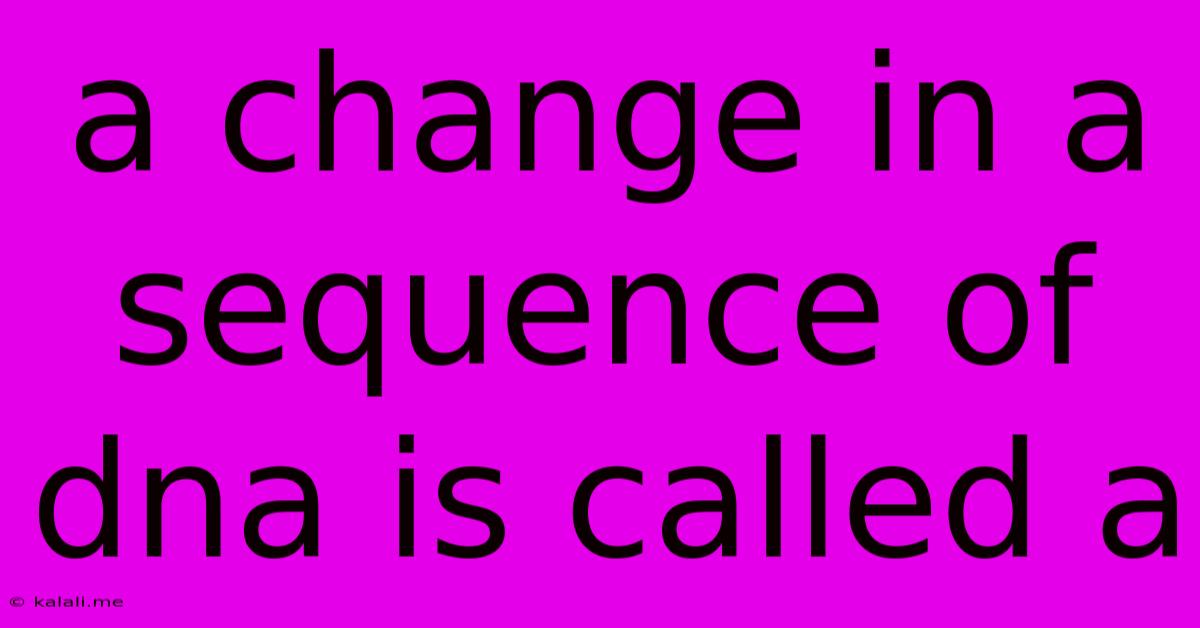A Change In A Sequence Of Dna Is Called A
Kalali
May 09, 2025 · 3 min read

Table of Contents
A Change in a Sequence of DNA is Called a Mutation: Understanding the Mechanisms and Impacts
A change in the sequence of DNA is called a mutation. This seemingly simple definition belies the profound impact these alterations can have on an organism, ranging from subtle effects to significant diseases and even evolutionary change. Understanding mutations is crucial for comprehending genetics, evolution, and various medical conditions. This article will delve into the different types of mutations, their causes, and their consequences.
What exactly is a mutation? It's essentially any change that alters the nucleotide sequence of a genome. This alteration can affect a single nucleotide, a small stretch of DNA, or even entire chromosomes. These changes can arise spontaneously or be induced by external factors.
Types of Mutations: A closer look
Mutations are broadly classified into several categories based on their scale and impact:
-
Point Mutations: These are the smallest-scale mutations, affecting only a single nucleotide base. There are three main subtypes:
- Substitution: One nucleotide base is replaced by another. This can lead to a silent mutation (no change in the amino acid sequence), a missense mutation (change in one amino acid), or a nonsense mutation (premature stop codon).
- Insertion: One or more nucleotides are added to the sequence.
- Deletion: One or more nucleotides are removed from the sequence. Insertions and deletions can cause frameshift mutations, altering the reading frame of the gene and potentially leading to significant changes in the amino acid sequence.
-
Chromosomal Mutations: These are larger-scale mutations that affect entire chromosomes or large segments of them. These include:
- Deletion: A segment of a chromosome is lost.
- Duplication: A segment of a chromosome is duplicated.
- Inversion: A segment of a chromosome is reversed.
- Translocation: A segment of a chromosome is moved to a different chromosome.
Causes of Mutations
Mutations can arise from a variety of sources:
- Spontaneous Mutations: These occur naturally during DNA replication due to errors in the process. These errors are relatively rare thanks to the sophisticated proofreading mechanisms of DNA polymerase.
- Induced Mutations: These are caused by external factors, known as mutagens. Examples of mutagens include:
- Radiation: UV radiation, X-rays, and gamma rays can damage DNA, leading to mutations.
- Chemical Mutagens: Certain chemicals, such as benzopyrene (found in cigarette smoke) and aflatoxins (produced by certain fungi), can react with DNA and cause mutations.
- Biological Mutagens: Certain viruses can insert their genetic material into the host's DNA, causing mutations.
The Impact of Mutations
The consequences of mutations vary widely. Some mutations are silent, having no noticeable effect on the organism. Others can be beneficial, providing a selective advantage that drives evolution. However, many mutations are harmful, causing genetic disorders or increasing the risk of diseases such as cancer. The severity of a mutation depends on several factors, including:
- The type of mutation: A frameshift mutation is generally more harmful than a silent mutation.
- The location of the mutation: A mutation in a critical gene will have a more significant impact than a mutation in a non-coding region.
- The organism's repair mechanisms: Cells have mechanisms to repair DNA damage, but these are not always perfect.
Conclusion
In summary, a change in the sequence of DNA is called a mutation. These changes can be small or large, spontaneous or induced, and have a wide range of effects on organisms. Understanding the different types, causes, and consequences of mutations is crucial for advancing our knowledge of genetics, evolution, and human health. Further research continues to unravel the complex interplay between mutations and their impact on the living world.
Latest Posts
Latest Posts
-
Understanding Theoretical Actual And Percent Yield
May 09, 2025
-
What Is The Common Factor Of 15 And 25
May 09, 2025
-
How Much Is 1 75 Liters In Gallons
May 09, 2025
-
How Many Degrees Celsius Is 50 Degrees Fahrenheit
May 09, 2025
-
What Is 15 Off Of 60
May 09, 2025
Related Post
Thank you for visiting our website which covers about A Change In A Sequence Of Dna Is Called A . We hope the information provided has been useful to you. Feel free to contact us if you have any questions or need further assistance. See you next time and don't miss to bookmark.